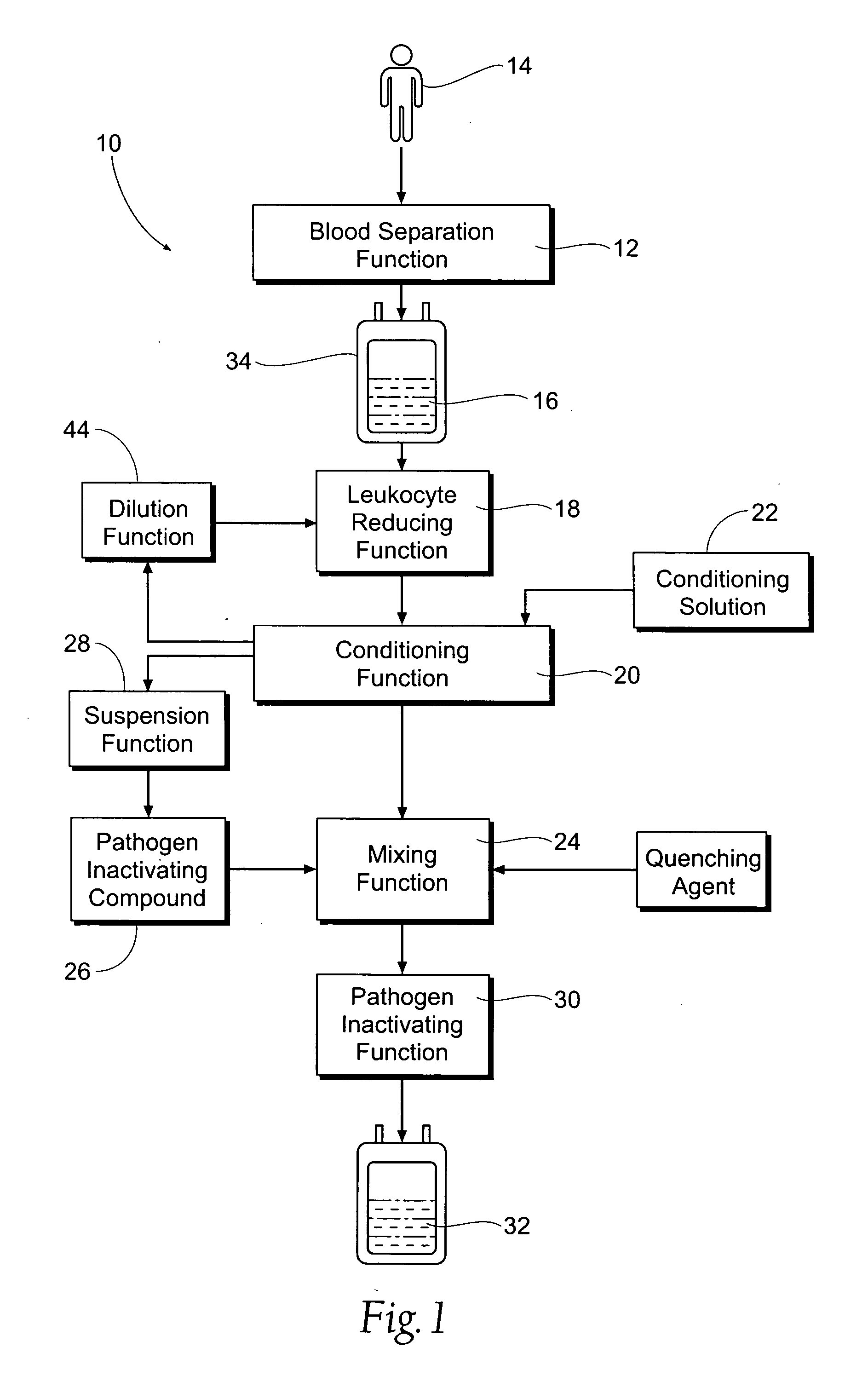Processing systems and methods for providing leukocyte-reduced blood components conditioned for pathogen inactivation
- Summary
- Abstract
- Description
- Claims
- Application Information
AI Technical Summary
Benefits of technology
Problems solved by technology
Method used
Image
Examples
example 1
Identifying Category A and Category Filtration B Media
[0054] Units of pRBC's (270 ml) were obtained by conventional manual centrifugation techniques from whole blood. The pRBC's were mixed with conventional Esol™ Solution at a 2:1 volumetric ratio. The pRBC-Esol mixtures were passed through various filtration media at room temperature and with no hold time after Esol™ Solution addition. The following Table summarizes the data (PASS indicates that the residual leukocyte population and / or RBC recovery in red blood cells mixed with the Esol™ Solution met selected standards of numbers of residual leukocytes and / or percentage of RBC recovery that can be achieved when red blood cells are filtered mixed with Adsol® Solution—in this Example, the standards selected were (1) having a residual leukocyte level that was less than 1×106 per unit with 95% confidence, 95% of the time and (2) a RBC recovery that was not less than about 89%, assuming a minimum 270 ml RBC unit. FAIL indicates that th...
example 2
Addition of Dextrose Leads to Improved Leukocyte Reduction During Filtration
[0060] pRBC's from a pooled source were mixed with various additive solutions at a 2:1 volumetric ratio. Filtration through an Asahi Flex RC™ filter (a Category A Filtration Medium) began five to six minutes after addition of solution. The following table shows the results:
TABLE 2Filtration of pRBC'sMixed with Esol-A SolutionModified with DextroseModified Esol-AEsol-A SolutionSolutionComposition(No Dextrose)(With Dextrose)Mannitol7.747.74g / LAdenine0.2150.215g / LDextrose0.020.0(anhydrous)g / LSodium7.827.82Citrate(dihydrate)g / LSodium.649.649Phosphate(monohydrate)g / LSodium2.422.42PhospateDibasic(anhydrous)Osmolarity178293mOsm / kgInitial1.86 × 1091.86 × 109LeukocytePopulationper 270 mlPost-2.43 × 1054.05 × 104FiltrationLeukocytePopulationper 270 ml
[0061] Table 2 demonstrates that the addition of dextrose to Esol-A Solution leads to improved leukocyte removal rates using a Category A Filtration Medium.
[0062] A r...
example 3
Addition of Sodium Chloride Leads to Improved Leukocyte Reduction During Filtration
[0070] pRBC's from a pooled source were mixed with various additive solutions at a 2:1 volumetric ratio. Filtration through an Asahi Flex RC™ filter (a Category A Filtration Medium) began five to six minutes after addition of solution. The following table shows the results:
TABLE 3Filtration of pRBC'sMixed with Esol-A SolutionModified Esol-Modified withEsol-A SolutionA SolutionSodium Chloride(No Sodium(With SodiumCompositionChloride)Chloride)Mannitol7.747.74g / LAdenine0.2150.215g / LSodium Chloride0.04.39g / LSodium Citrate7.827.82(dihydrate) g / LSodium Phosphate.649.649(monohydrate) g / LSodium Phospate2.422.42Dibasic(anhydrous)Osmolarity178315mOsm / kgInitial Leukocyte1.86 × 1091.97 × 109Populationper 270 mlPost-Filtration2.43 × 1055.40 × 104LeukocytePopulationper 270 ml
[0071] Table 3 demonstrates that the addition of sodium chloride to Esol-A Solution leads to improved leukocyte removal rates when using a ...
PUM
 Login to View More
Login to View More Abstract
Description
Claims
Application Information
 Login to View More
Login to View More - R&D
- Intellectual Property
- Life Sciences
- Materials
- Tech Scout
- Unparalleled Data Quality
- Higher Quality Content
- 60% Fewer Hallucinations
Browse by: Latest US Patents, China's latest patents, Technical Efficacy Thesaurus, Application Domain, Technology Topic, Popular Technical Reports.
© 2025 PatSnap. All rights reserved.Legal|Privacy policy|Modern Slavery Act Transparency Statement|Sitemap|About US| Contact US: help@patsnap.com



